Research - (2021) Volume 9, Issue 2
Awareness and Knowledge of Coronavirus Diagnostic Test among Dental Students
Preethi Shankar1, Preetha S1* and Lavanya Prathap2
*Correspondence: Preetha S, Departments of Physiology, Saveetha Dental College and Hospitals, Saveetha Institute of Medical and Technical Sciences (SIMATS), Saveetha University Tamilnadu, India, Email:
Abstract
Coronavirus is a disease seen in mammals and affects the respiratory tract. It originated in China. Symptoms of the virus are common cold, SARS, MERS. Social distancing is the only method to fight against this disease effectively. Coronavirus diagnostic tests are used to prevent disease from spreading from one person to another. Molecular tests are carried out by collecting mucus and mixing it with the reagents, due to this virus genome is replicated and Abbot’s molecular test provides results. Swan test and molecular test are the two diagnostic tests carried out. Coronavirus diagnostic tests help in easy detection of viruses. The test prevents the spread of viruses to many people; this test is considered as a reliable test. The study aims at determining the awareness and knowledge of coronavirus diagnostic tests among dental students. A questionnaire comprising 13 questions was created and circulated among 100 dental students. The results were collected and analysed. It was evident that the dental students possessed very little knowledge about the diagnostic tests and its advantages. Awareness about diagnostic tests among dental students should be high in order to control the spread of virus and to isolate the infected persons.
Keywords
Medical and health science course, Coronavirus, Pandemic, COVID-19, Medical profession, Anxiety
Introduction
Coronavirus is a disease seen usually in mammals and birds. The virus contributes to respiratory tract infection. The virus was first discovered in Chinese horseshoe bats. The virus spreads from one person to another through droplets. Symptoms of the virus are common cold, SARS, MERS [1-3].
Coronavirus diagnostic test is a test carried out to prevent the spread of coronavirus. The test is carried out to make an individual aware that he is suffering from the disease. Tests carried out for corona are Swan tests and blood tests, Septum tests, molecular tests, serological tests [4]. Molecular tests are carried out by collecting mucus and mixing it with the reagents, due to this virus genome is replicated and Abbot’s molecular test provides results [5]. A Serological test is a test carried out based on a measure of antibodies. The test detects the body’s immune system and response to infection caused by viruses [6]. Social distancing is the only method to fight against this disease effectively [7].
Coronavirus diagnostic tests help in easy detection of viruses. The test prevents the spread of viruses to many people. The test is considered as a reliable test [8]. The main objective of the test is to isolate the infected person from the rest of the population [9]. The potential promise of the topic is to bring awareness among dental students about coronavirus tests and also to increase the exposure of the dental students by taking appropriate precautions and to control viruses and isolate the infected persons.
The aim of the study is to increase awareness and knowledge among dental students about the coronavirus diagnostic test and to assess the dental students to direct their patients.
Material and Methods
A survey was conducted among 100 dental students of Saveetha dental college. The survey contained 13 questions. The survey was conducted through an online basis and the questions asked were closed ended questions. Software used was google forms. Method of representation of data was using bar graphs.
Statistical software used is Spss. Correlation analysis was done by chi square test using SPSS software. Steps followed during analysis are data interpretation and analysis. Statistical type of analysis carried out was analysis of survey. List of dependent variables in the survey are knowledge in the coronavirus diagnostic test. List of independent variables are age and sex. Bar graphs were mainly used to represent the number of observations produced. Questionnaire validity checking was done by consulting experts.
Results and Discussion
The response of the survey was collected and tabulated in the form of bar graphs. When inquired about the awareness of the coronavirus diagnostic test, 98% of the participants responded. It was disappointing to find that dental students had mere knowledge about the coronavirus test.
The questions asked in the survey were based on coronavirus, its seriousness, and ways to prevent its spread and also about the coronavirus diagnostic tests. In the present study, only 56% of the population was aware of the seriousness of the corona while 44% were not aware (Figures 1 and 2]. 63% of the students were aware that washing hands prevents us from corona and its spread while 30% believes 30 seconds and 7% of the students believe 1 minute (Figure 3). 64% of the students were only aware that vaccines have not been developed for coronavirus yet while the other 36% of the students believe that the vaccine has been developed for coronavirus (Figure 4). In the present study, 41% of the students were unaware of social distancing and 59% of the students were aware of coronavirus testing (Figure 5). Only 71% of the students were aware that coronavirus affects the respiratory tract while the remaining students believe the virus attacks the digestive and circulatory system (Figure 6). Locality of 51% of the dental students was affected with Coronavirus and 49% of the students locality was not affected (b). In the current study, 63% of the students consider gloves as a measure to prevent coronavirus spread while 37% of the students does not consider gloves as a precautionary material (Figure 8). 54% of the students were aware of the coronavirus diagnostic test while 46% were not aware (Figure 9). In the present study, 47% of the students were aware of the invention of diagnostic kits in India while 53% of the students were unaware (Figure 10). For the samples used for coronavirus diagnostic testing, 32% believed blood test, 32% believed throat swab test and 36% believed both blood test and throat swab test (Figure 11). For the test used for coronavirus diagnostic test, 32% believed PCR, 57% believe PCP and 11% believed PPR (Figure 12). 65% of the students were aware of the precaution against coronavirus infection and 35% were not aware (Figures 13-18). Coronavirus is spreading at a high rate all over the world, the affected person is hospitalized for several days so it is therefore necessary to understand the seriousness of the virus and take precautions against it [10]. People of age 60 years or above are more vulnerable to the virus as they have weak immune systems. Early diagnosis, isolation and supportive care for affected persons prevent the spread of viruses [11]. Social distancing is one of the most effective methods to overcome the virus with a distance of 1 m from everyone [7]. Doing physical education on a regular basis also helps our body to fight against the virus [7,12].
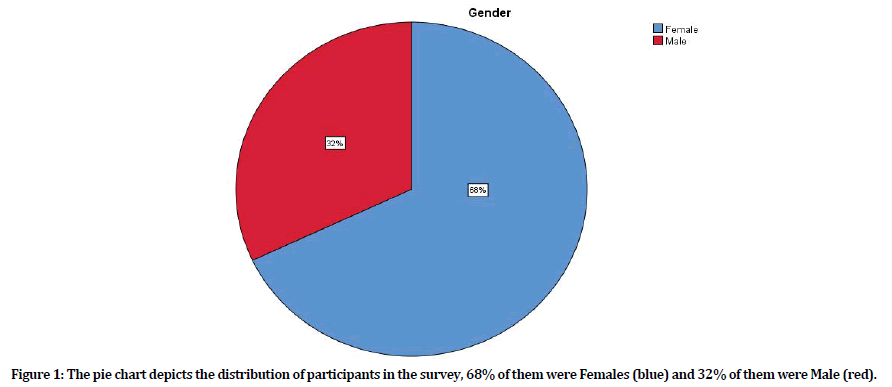
Figure 1. The pie chart depicts the distribution of participants in the survey, 68% of them were Females (blue) and 32% of them were Male (red).
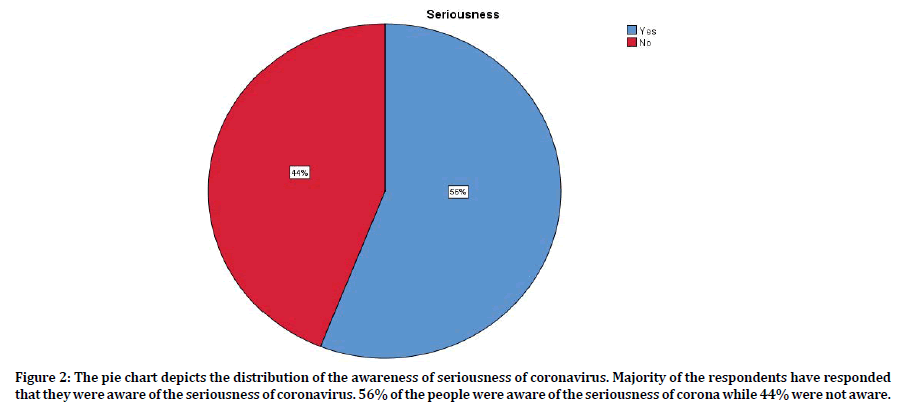
Figure 2. The pie chart depicts the distribution of the awareness of seriousness of coronavirus. Majority of the respondents have responded that they were aware of the seriousness of coronavirus. 56% of the people were aware of the seriousness of corona while 44% were not aware.
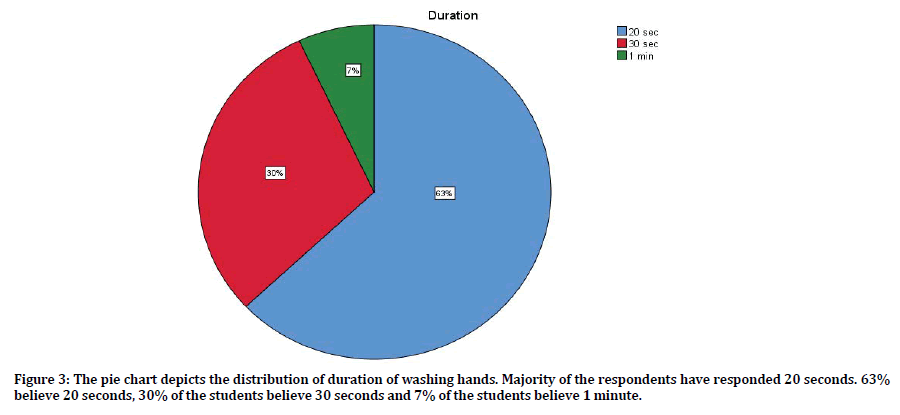
Figure 3. The pie chart depicts the distribution of duration of washing hands. Majority of the respondents have responded 20 seconds. 63% believe 20 seconds, 30% of the students believe 30 seconds and 7% of the students believe 1 minute.
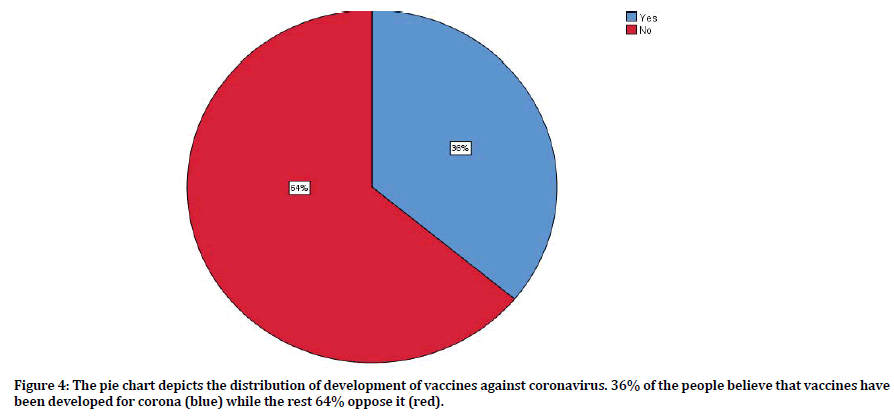
Figure 4. The pie chart depicts the distribution of development of vaccines against coronavirus. 36% of the people believe that vaccines have been developed for corona (blue) while the rest 64% oppose it (red).
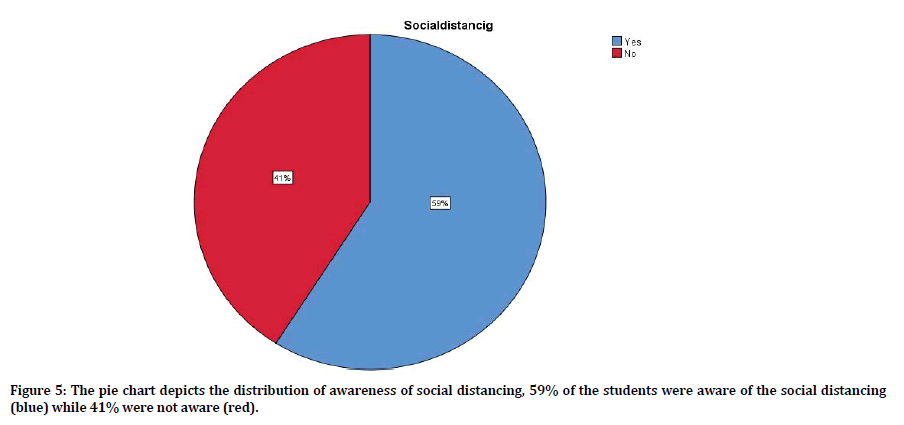
Figure 5. The pie chart depicts the distribution of awareness of social distancing, 59% of the students were aware of the social distancing (blue) while 41% were not aware (red).
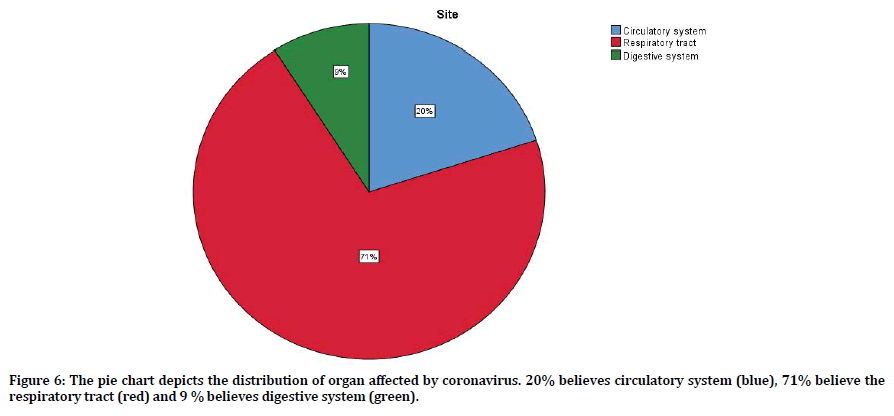
Figure 6. The pie chart depicts the distribution of organ affected by coronavirus. 20% believes circulatory system (blue), 71% believe the respiratory tract (red) and 9 % believes digestive system (green).
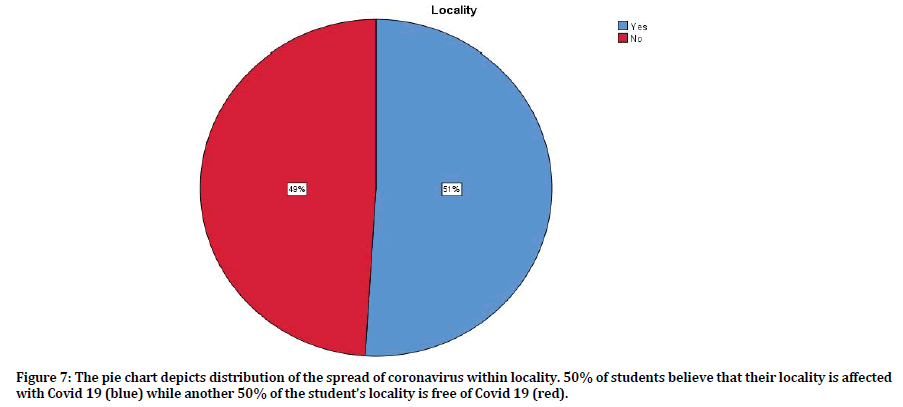
Figure 7. The pie chart depicts distribution of the spread of coronavirus within locality. 50% of students believe that their locality is affected with Covid 19 (blue) while another 50% of the student’s locality is free of Covid 19 (red).
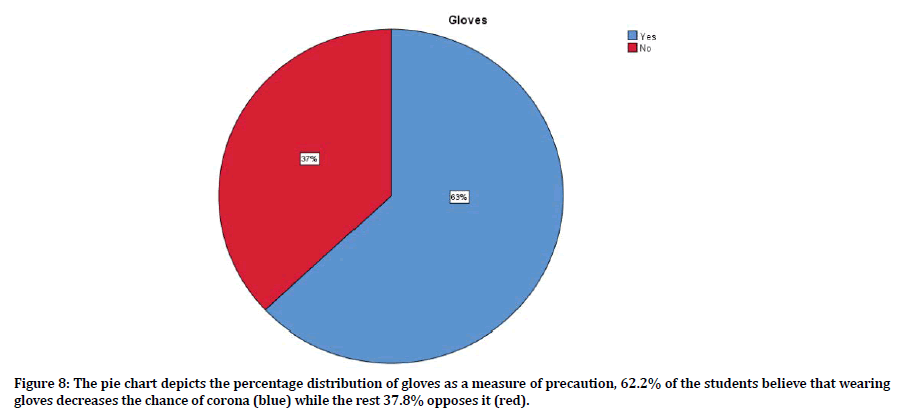
Figure 8. The pie chart depicts the percentage distribution of gloves as a measure of precaution, 62.2% of the students believe that wearing gloves decreases the chance of corona (blue) while the rest 37.8% opposes it (red).
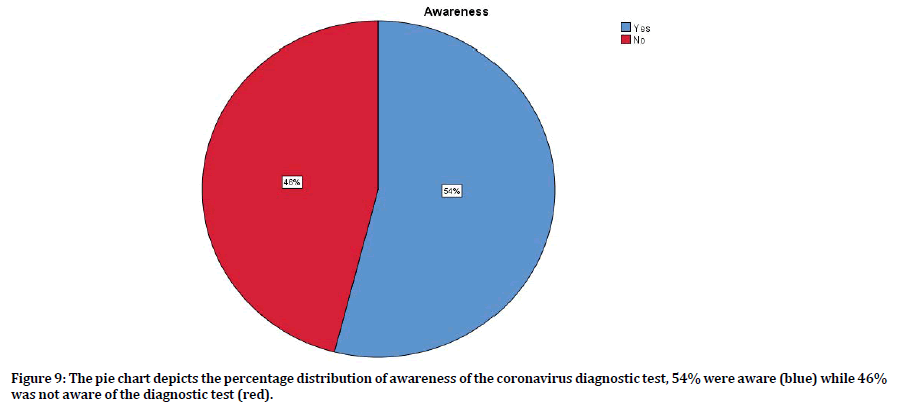
Figure 9. The pie chart depicts the percentage distribution of awareness of the coronavirus diagnostic test, 54% were aware (blue) while 46% was not aware of the diagnostic test (red).
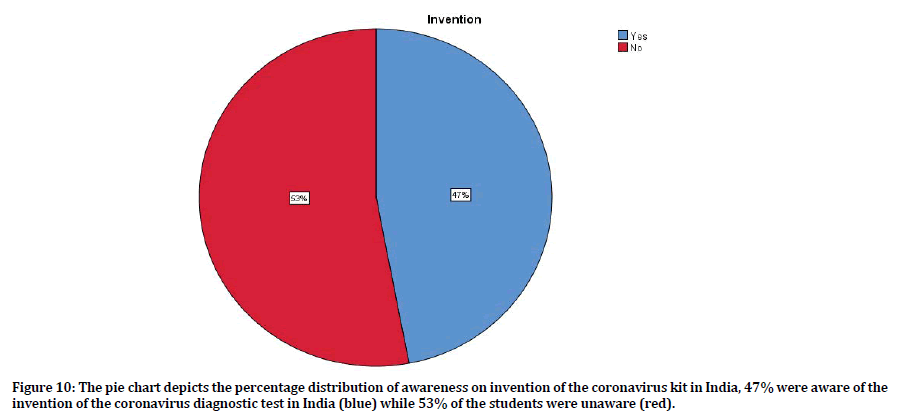
Figure 10. The pie chart depicts the percentage distribution of awareness on invention of the coronavirus kit in India, 47% were aware of the invention of the coronavirus diagnostic test in India (blue) while 53% of the students were unaware (red).
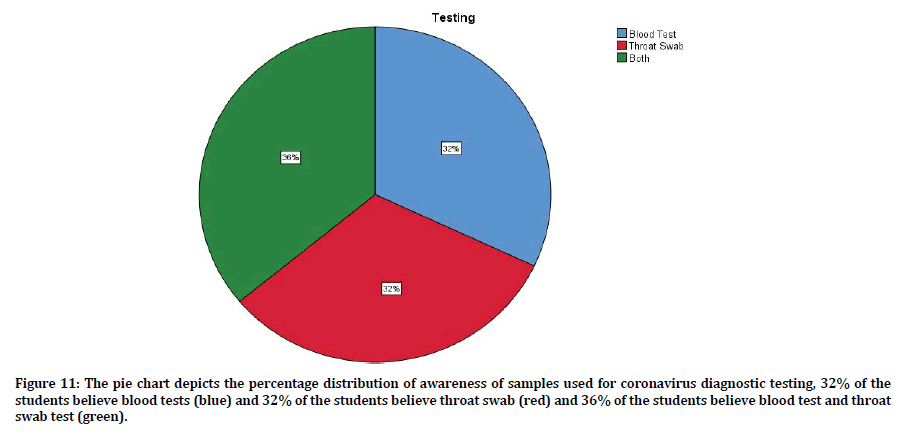
Figure 11. The pie chart depicts the percentage distribution of awareness of samples used for coronavirus diagnostic testing, 32% of the students believe blood tests (blue) and 32% of the students believe throat swab (red) and 36% of the students believe blood test and throat swab test (green).
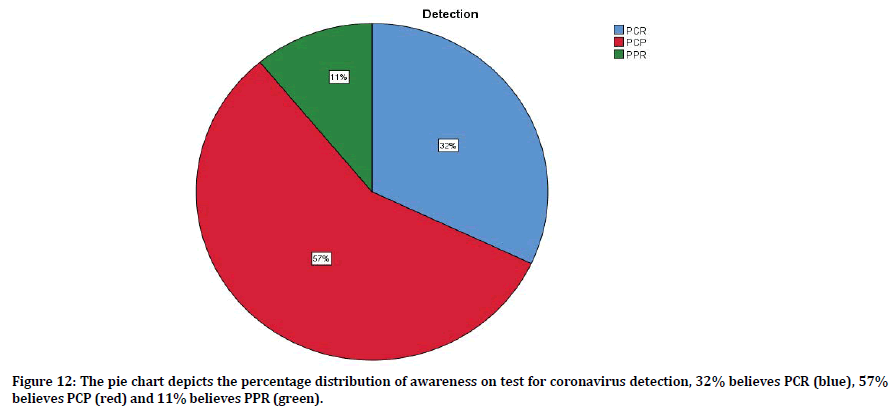
Figure 12. The pie chart depicts the percentage distribution of awareness on test for coronavirus detection, 32% believes PCR (blue), 57% believes PCP (red) and 11% believes PPR (green).
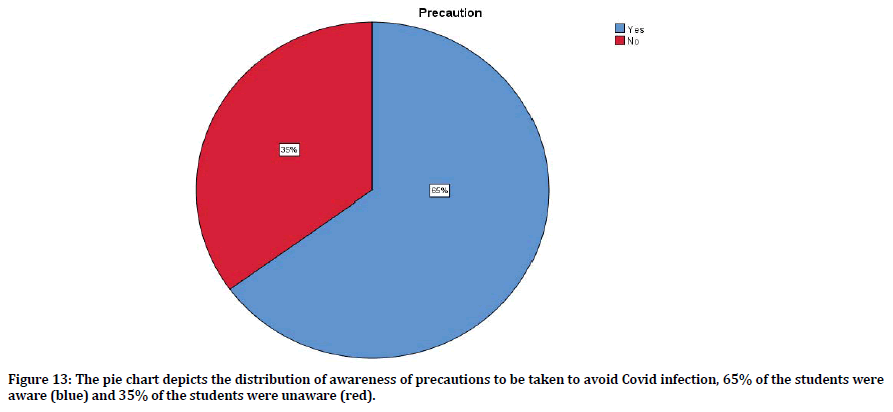
Figure 13. The pie chart depicts the distribution of awareness of precautions to be taken to avoid Covid infection, 65% of the students were aware (blue) and 35% of the students were unaware (red).
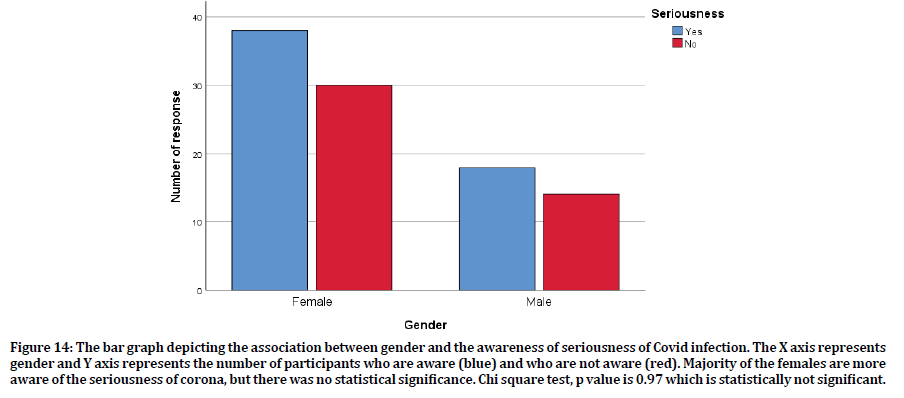
Figure 14. The bar graph depicting the association between gender and the awareness of seriousness of Covid infection. The X axis represents gender and Y axis represents the number of participants who are aware (blue) and who are not aware (red). Majority of the females are more aware of the seriousness of corona, but there was no statistical significance. Chi square test, p value is 0.97 which is statistically not significant.
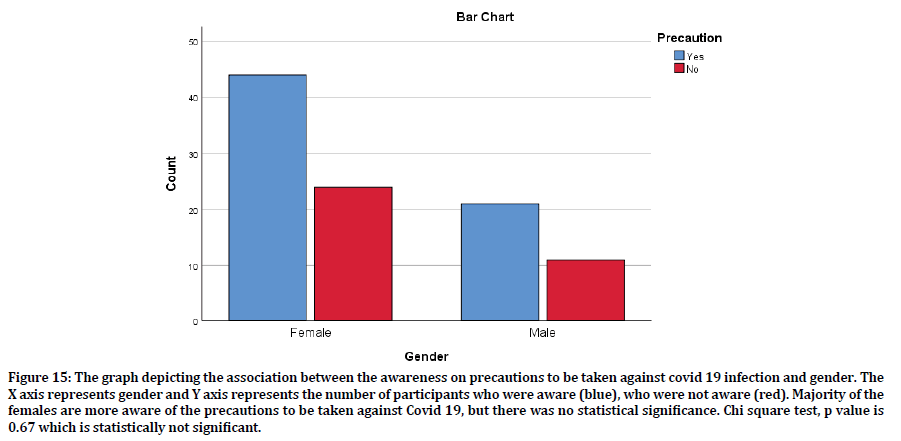
Figure 15. The graph depicting the association between the awareness on precautions to be taken against covid 19 infection and gender. The X axis represents gender and Y axis represents the number of participants who were aware (blue), who were not aware (red). Majority of the females are more aware of the precautions to be taken against Covid 19, but there was no statistical significance. Chi square test, p value is 0.67 which is statistically not significant.
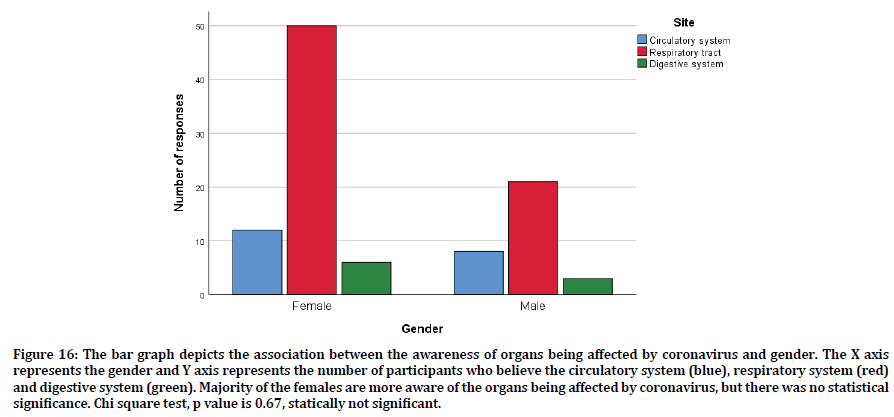
Figure 16. The bar graph depicts the association between the awareness of organs being affected by coronavirus and gender. The X axis represents the gender and Y axis represents the number of participants who believe the circulatory system (blue), respiratory system (red) and digestive system (green). Majority of the females are more aware of the organs being affected by coronavirus, but there was no statistical significance. Chi square test, p value is 0.67, statically not significant.
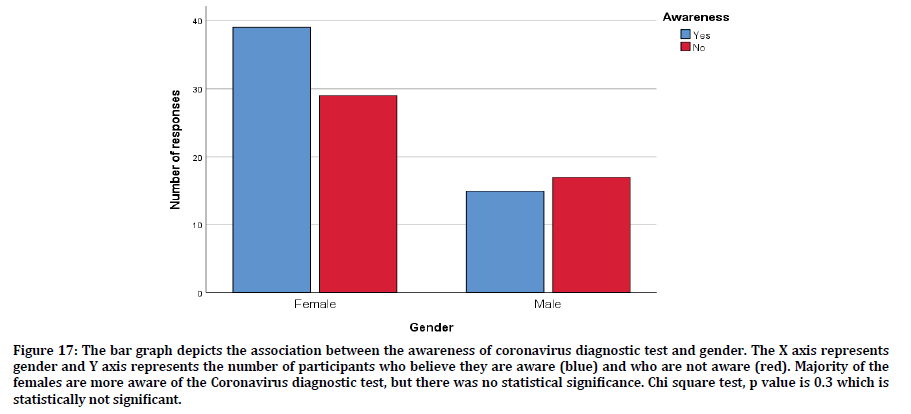
Figure 17. The bar graph depicts the association between the awareness of coronavirus diagnostic test and gender. The X axis represents gender and Y axis represents the number of participants who believe they are aware (blue) and who are not aware (red). Majority of the females are more aware of the Coronavirus diagnostic test, but there was no statistical significance. Chi square test, p value is 0.3 which is statistically not significant.
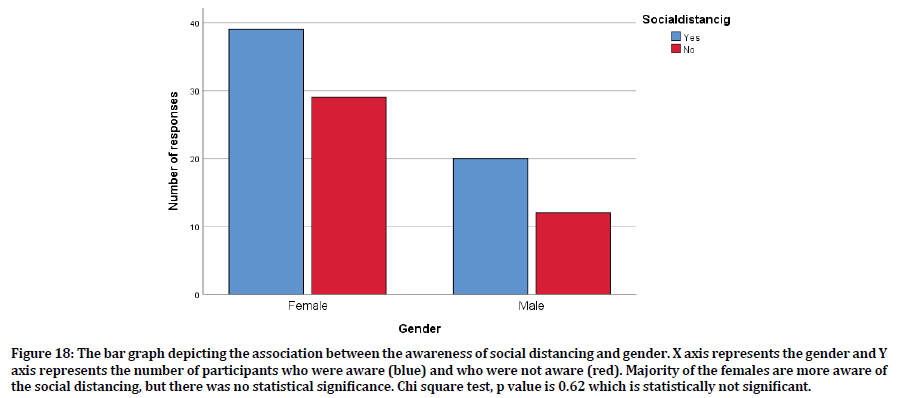
Figure 18. The bar graph depicting the association between the awareness of social distancing and gender. X axis represents the gender and Y axis represents the number of participants who were aware (blue) and who were not aware (red). Majority of the females are more aware of the social distancing, but there was no statistical significance. Chi square test, p value is 0.62 which is statistically not significant.
Previously we have studied awareness on various topics [13-18] and now the present study assesses the awareness of the coronavirus diagnostic kit among dental students. Various awareness studies and surveys have been performed in dental students [19-22] but none of the studies have focused on the importance of the coronavirus diagnostic test. Dental personnel’s must take precautions towards patients with coronavirus to limit the rate of infection [23]. Once the virus enters our body it regenerates and multiplies and occupies and accepts all the organ system mainly the respiratory tract and myocardial infarction people are more vulnerable to the virus as they lack required immunity [24]. Studies related to the methods to boost our immunity [25] against the virus have been carried out [26].
Conclusion
From the study it is evident that the dental students, though well aware of coronavirus infections, mode of transmission and its symptoms, possess limited knowledge about coronavirus diagnostic tests. Since coronavirus is a common talk across the entire world, it is necessary to be aware of the diagnostic tests commonly used for diagnosis. The survey was effective and this survey can be carried out in future to generate the awareness and knowledge among large groups about coronavirus diagnostic tests.
References
- Poon LLM, Chu DKW, Chan KH, et al. Identification of a novel coronavirus in bats. J Virol 2005; 79:2001–2009.
- Holmes KV. SARS-associated coronavirus. N Engl J Med 2003; 348:1948–1951.
- Sung H, Park SJ, Woo YD, et al. Evaluation of seeplex RV detection kit for detecting rhinovirus, human metapneumovirus, and coronavirus. Korean J Lab Med 2008; 28:109–117.
- Cavanagh D. Coronavirus avian infectious bronchitis virus. Vet Res 2007; 38:281–297.
- Crotty S, Cameron CE, Andino R. RNA virus error catastrophe: direct molecular test by using ribavirin. Proc Natl Acad Sci 2001; 98:6895–900.
- Irani SR, Pettingill P, Kleopa KA, et al. Morvan syndrome: Clinical and serological observations in 29 cases. Annals Neurol 2012; 72:241–255.
- Westphal JD, Khanna P. Keeping directors in line: Social distancing as a control mechanism in the corporate elite. Administrative Sci Quarterly 2003; 48:361.
- Yang S, Rothman RE. PCR-based diagnostics for infectious diseases: uses, limitations, and future applications in acute-care settings. Lancet Infect Dis 2004; 4:337–348.
- Sabino-Silva R, Jardim ACG, Siqueira WL. Coronavirus COVID-19 impacts to dentistry and potential salivary diagnosis. Clin Oral Investigations 2020; 24:1619–1621.
- Meng L, Hua F, Bian Z. Coronavirus disease 2019 (COVID-19): Emerging and future challenges for dental and oral medicine. J Dent Res 2020; 99:481–487.
- Myrstad M, Ranhoff AH. Acutely ill older people in the corona era. Tidsskr Nor Laegeforen 2020; 140.
- Corbin CB, Pangrazi RP, Le Masurier GC. Physical Activity for children: Current patterns and guidelines. J Physical Activity Health 2004; 1:281.
- Baheerati MM, Gayatri Devi R. Obesity in relation to Infertility. Res J Pharm Technol 2018; 11:3183.
- Fathima F, Preetha P. Evaluation of thyroid function test in obese patients. [Internet]. Asian J Pharm Clin Res 2016; 9:353.
- Rj I, R GD. Role of environmental factors on sleep patterns of different age groups. Asian J Pharma Clin Res 2016; 9:124.
- Harsha L, Priya J, Shah KK, et al Systemic approach to management of neonatal jaundice and prevention of kernicterus. Res J Pharm Technol 2015; 8:1087.
- Dave PH, Preetha. Pathogenesis and novel drug for treatment of asthma-A review. Res J Pharm Technol 2016; 9:1519.
- R GD, Sethu G. Evaluation of adenoids by oronasal and nasal spirometry. Asian J Pharma Clin Res 2018; 11:272.
- Shruthi M, Preetha S. Effect of simple tongue exercises in habitual snorers. Res J Pharm Technol 2018; 11:3614.
- Choudhari S, Jothipriya MA. Non-alcoholic fatty liver disease. Res J Pharm Technol 2016; 9:1782.
- Iyer PK, Gayatri Devi R, Jothi Priya A. A survey study on causes, treatment and prevention of onychocryptosis. Indian J Public Health Res Develop 2019; 10:807.
- Timothy CN, Gayatri Devi R, Jothi Priya A. Evaluation of peak expiratory flow rate (PEFR) in pet owners. Indian J Public Health Res Develop 2019; 10:803.
- Priya AJ, Devi G. Physical fitness among the dental physician, dental undergraduates and postgraduates students. Indian J Public Health Research Develop 2019; 10.
- Renuka S, Sethu G. Regeneration after myocardial infarction. Res J Pharm Technol 2015; 8:738.
- Priya J, Devi G. Evaluation of muscular endurance among dentists. Indian J Public Health Res Develop 2019; 10.
- Swathy S, Gowri Sethu V. Acupuncture and lower back pain. Res J Pharm Technol 2015; 991.
Author Info
Preethi Shankar1, Preetha S1* and Lavanya Prathap2
1Departments of Physiology, Saveetha Dental College and Hospitals, Saveetha Institute of Medical and Technical Sciences (SIMATS), Saveetha University Tamilnadu, India2Departments of Anatomy, Saveetha Dental College and Hospitals, Saveetha Institute of Medical and Technical Sciences (SIMATS), Saveetha University Tamilnadu, India
Citation: Preethi Shankar, Preetha S, Lavanya Prathap, Awareness and Knowledge of Coronavirus Diagnostic Test among Dental Students, J Res Med Dent Sci, 2021, 9 (2):393-401.
Received: 27-Sep-2020 Accepted: 22-Feb-2021
